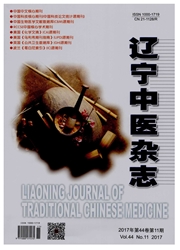

 中文摘要:
中文摘要:
目的:观察腰椎"椎骨错缝"大鼠模型造模节段生物力学及坐骨神经传导速度的变化。方法:将160只350~450 g雄性SD大鼠随机分为实验组、对照组、假手术组及空白对照组。再将各组按固定时间分为1、2、4、8和12周5个亚组。实验组和对照组通过外科手术方法在其L4、L5和L6棘突上均植入外固定连接装置的棘突附着部件,实验组在此基础上再植入外部连接部件,假手术组仅行手术干预,空白对照组不行任何干预。在各连接期结束时,脊柱刚度测试系统检测实验组和对照组固定节段刚度;肌电诱发电位仪检测各组坐骨神经传导速度。结果:刚度检测结果显示实验组大鼠脊柱造模节段刚度随连接时间的延长而增加,其中从8周开始实验组刚度出现明显变化。神经电生理示造模节段相应脊神经传导速度逐渐减慢。结论:椎骨错缝大鼠模型可引起相应造模节段脊椎生物力学特性的变化及神经电生理的改变,且此种变化与时间相关。
 英文摘要:
英文摘要:
Objective: To observe the variation of segmental biomechanics and NCS subluxation rat model. Methods: 160 healthy male Sprague- Dawley( 350- 450 g) rats are randomly divided into experimental group,control group,sham operated group and blank group. Each group was redivided into 5 sub- groups according to fixation time( 1,2,4,8 and 12 weeks). The rigidity of the fixed spinal segment of the experimental and control group was tested by rigidity test system of spine at the end of connection.NCV of lower extremity of rat model was examined by myoelectricity evoked potential otentiometer. Results: The rigidity of the spinal segment of subluxation rat model increased along with the connection time and the NCV of sciatic nerve of rat model decreased gradually from the eighth week. Conclusion: The subluxation rat model may lead to the change of spinal biomechanics and nerve electrophysiology of the corresponding model segment and the change is time related.
 同期刊论文项目
同期刊论文项目
 同项目期刊论文
同项目期刊论文
 期刊信息
期刊信息
